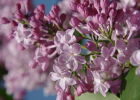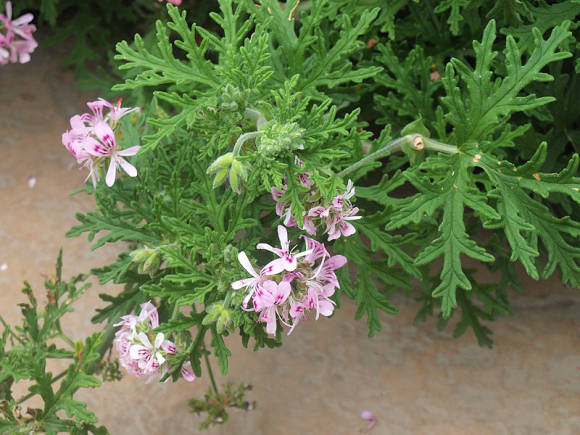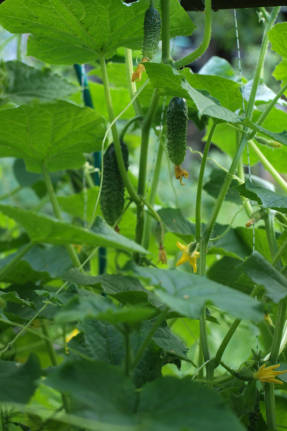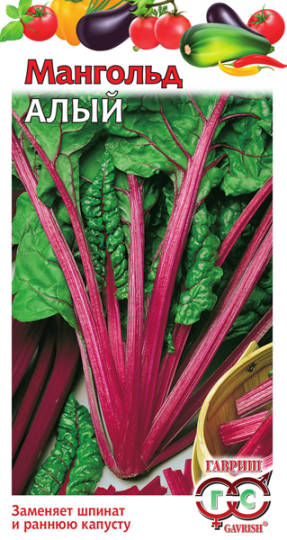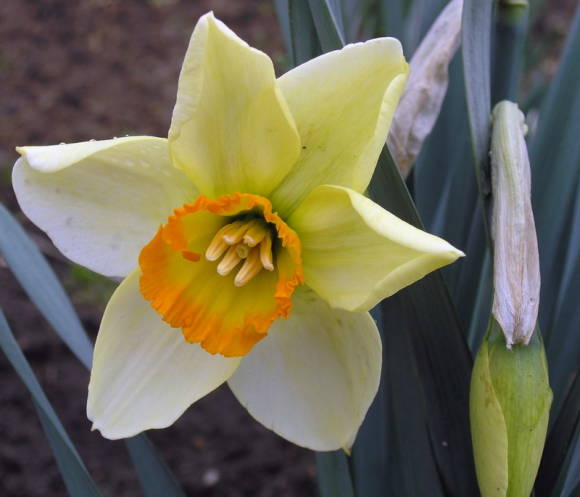 |
In the isolated western territory of Russia, in the city of Kaliningrad, there is a botanical garden. In 1904, it was founded by the German professor Paul Kaeber, head of the Department of Higher Plants and Systematics at the University of Königsberg (then called "Albertina" in honor of the first Duke of Prussia Albrecht, 1490-1568). In those days, the garden was called "Urban Gardening", because was created by the decision of the City Administration, funded by the city treasury, and was intended to teach gardening skills to schoolchildren and the local population. The grown plants were used to decorate the capital and suburbs of East Prussia. "Gardening" was founded in one of the most beautiful suburbs of Königsberg - Maraunenhof, which in a modern city is surrounded by Lesnaya and Molodezhnaya streets and the railway to Zelenogradsk. The first director of "Gardening" P. Kaber collected a collection of winter-hardy plants and numerous representatives of the tropics and subtropics, built 5 greenhouses for them. He died in 1919, as evidenced by the inscription on the granite boulder preserved in the Garden.
By 1938, the rich collection of greenhouse plants numbered about 4 thousand taxa. However, at the end of World War II, the greenhouses were destroyed (only the frames survived), and the German collections were completely lost. The formation of a new collection of thermophilic species and forms began after the reconstruction of the old greenhouses and the extension of the greenhouse. Some tropical and subtropical plants were introduced in 1959-1960 from the Main Botanical Garden (Moscow). In the future, the Garden staff replenished the collection at the expense of seeds, cuttings and seedlings from other botanical gardens, as well as receiving plants as a gift from amateur gardeners.
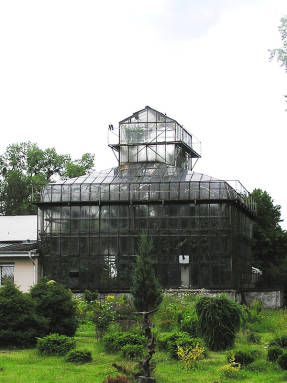 | 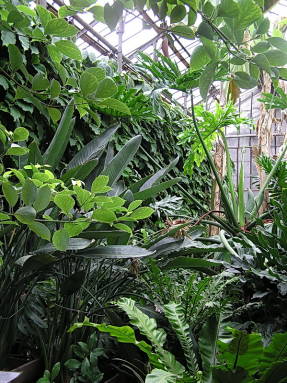 |
Since 1967, the botanical garden in Kaliningrad has been a university educational base for botany and ecology. Since 2011, it belongs to the Immanuel Kant Baltic Federal University. The garden covers an area of more than 13 hectares, which houses 6 greenhouses, areas of herbaceous and woody plants, greenhouses, a nursery and utility rooms, there is even a picturesque pond of 1 hectare, framed by weeping willows.
 |
The modern botanical garden in Kaliningrad possesses valuable collections of more than 2,500 taxa belonging to 1,600 plant species. Species that are rare in the nature of Russia and the Baltic countries, listed in the Red Books, are given special care. More than 30 protected species - junipers (Juniperussabina, J. rigida), cross-pair microbiota (Mictobiotadecussata), berry yew (Taxusbaccata), field maple (Acercampestre), Maksimovich birch (Betulamaximowicziana), rhododendrons (Rhododendronluteum, Rh. schlippenbachii), securinega (Securinegasuffruticosa), prinsepia (Prinsepiasinensis), Caucasian klekachki (Staphyleapinnata, S. colchica), pterygoid lapina (Pterocaryapterocarpa), reaching 90 years of age and other species. By right, the eastern biota (Biotaorientalis), nutkan cypress (Chamaecyparisnootkatensis), swamp cypress (Taxodiumdistichum) and Geoffrey's pine (Pinusjeffreyi).
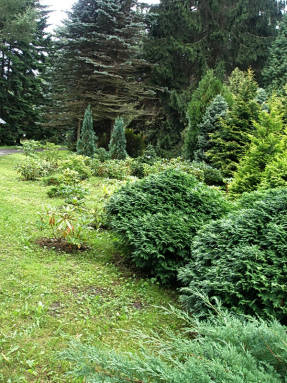 | 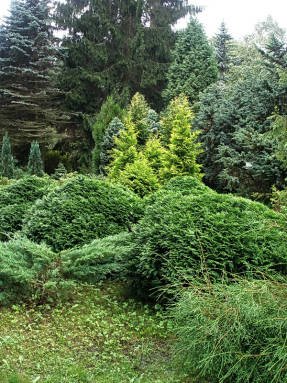 |
900 taxa are grown in the arboretum, among them 62 species are old trees planted in the period 1883-1924. The oldest oaks and beeches are 107-128 years old. Black pine (Pinusnigra) - the most beautiful and especially beloved in Europe, besides, it tolerates the unfavorable conditions of the city better than other pines. Black pine in the arboretum is represented by two subspecies: Austrian (Pinusnigrasubsp. nigra= P. n. var. austriaca= P. austriaca)and Pallas(subsp. pallasiana= P. pallasiana). The powerful trunks of the Pallas pine are covered with a lighter bark than that of the main species, similar to the bark of larch; these are the tallest pines of the Garden, planted in 1909, directed to a height of 20 m. It is interesting that under natural conditions this subspecies of black pine lives for 350-500 years, is protected in the Crimea, and in the nature of Russia it is found only near the village.Arkhipo-Osipovka (near Gelendzhik), and in addition, there is in Turkey, on the islands of Crete and Cyprus, in the east of the Balkan Peninsula and in the south - up to the Peloponnese (Greece).
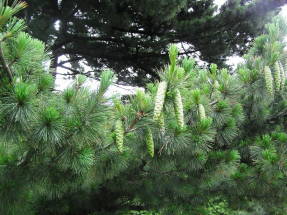 |
The 100-year-old Pevka pine (Pinuspeuce) 17 m high with a dense crown hung with graceful elongated cones. It was named in 1839 by the German botanist Heinrich Grisebach (1814-1879) after the ancient goddess Pevka. However, the tree also has a second name - Rumelia pine, which indicates its origin from the Turkish province of Rumelia in the former Ottoman Empire.
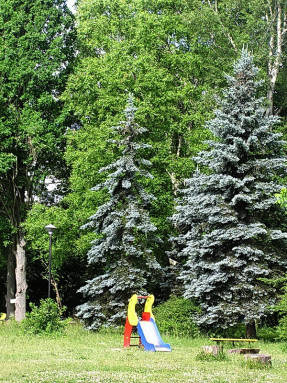 |
In the neighborhood, in a clearing, there are powerful blue thorny spruces (form Glauca), under them a playground is arranged, where restless kids frolic. In the collection of conifers of the arboretum, there are 27 forms of thuja (Thuja), so varied in habit: dwarf, medium-sized, giant; on the outline of the crown - spherical (Thujaoccidentalis ‘Globosa’, ‘GlobosaNana’, Hoveyi’), umbrella (‘Umbraculifera’), conical, orpyramidal(‘DouglassiiPyramidalis’, ‘Wagneriana’),columnar(‘Columna’); by the color of the needles - golden, golden-motley(‘Aureo-Spicata’, ‘EllwangerianaAurea’,‘Lutea’, ‘Rheingold’, ‘WareanaLutescens’), white and mottled(‘RecurvataArgenteo-Variegata’, ‘Variegata’), there is even a fern (‘Filicoides’),heather (‘Ericoides’) and threadlike (‘Filiformis’). There is a good collection of junipers (6 types and 38 forms), 8 types of firs, 5 types of larch, 14 types of pines, 10 types of spruces, cypress trees.- 3 types and 22 shapes. In the collection of conifers there are 3 types and 22 forms of cypress trees: K. Lawson, K. pea and K. Nutkan.
There are about 700 hardwood taxa in the arboretum. A tree made of legumes amazes with its grandeur - Kentucky cladrastis (Cladrastiskentukea). At home in North America, it is called "American yellow acacia." This nearly thirty-year-old specimen is annually strewn with drooping white-yellow fragrant inflorescences. Not far from the entrance in 1976, a rough-fruited poplar was planted and grew until 2012 (Populuslasiocarpa), originating from Western China and distinguished by an unusually bright crust, but it could not stand climatic cataclysms.
At the entrance to the garden, a variegated ash-leaved maple (Acernegundo‘Variegatum’), another variegated specimen is the Drummond Norway maple (Acerplatanoides ‘Drumondii’) is clearly visible from different points of the garden. In addition, 15 more species of maple grow here, many of which are represented by decorative varieties.
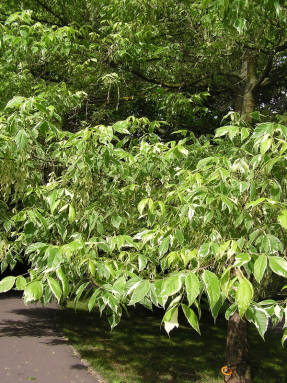 | 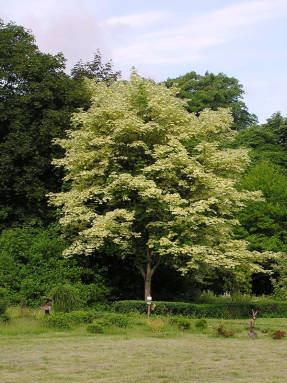 |
The entire area near the entrance to the Botanical Garden is decorated not only with bright summer houses and low-growing junipers, but also with fancy wooden figures and fairy-tale characters. Here are exhibited "giraffes", "dolphin", "squirrel", "deer", "snail", "wolf", "fox", "princess-frog" and even "imp", skillfully carved by the theatrical artist A. Possokhov , who, despite his considerable age, varnishes and tints crafts, keeping them from precipitation and bad weather.
 |  |
 |  |
The open area is allocated for planting 11 collections of herbaceous perennials, in total there are 17 such areas in the garden. The collection of peonies (on an area of 400 m2) - 5 species and 34 varieties, very beautiful delicate varietiespeony lactobacillus (Paeonialactiflora)... In spring, 36 varieties of daffodils, 97 varieties of tulips and more than 100 varieties of irises bloom, Ruyter's hybrid eremurus(Eremurusruiter ‘Cleopatra’).
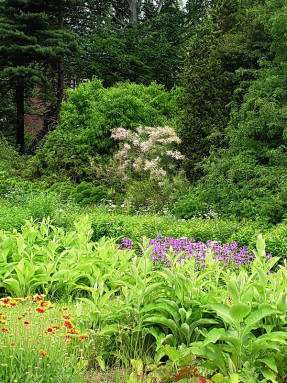 | 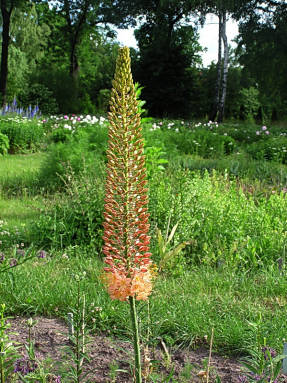 |
Most species and varieties of daylilies (59 taxa) and phlox (38 varieties) bloom in the second half of summer. The decorativeness of the plantings is complemented by an elegant crown with variegated foliage of a whole-leafed willow Japanese form Hakuro-Nishiki (Salixintegra ‘Hakuro-Nishiki’), flowering branched tamarix (Tamarixramosissima).Nearby, under the crowns of trees, lush actions (Deutziascabra ‘Candidissima’,‘Plena’), weigels (Weigelaflorida ‘Variegata’) and chubushniki (Philadelphuscoronarius ‘Aureus’).
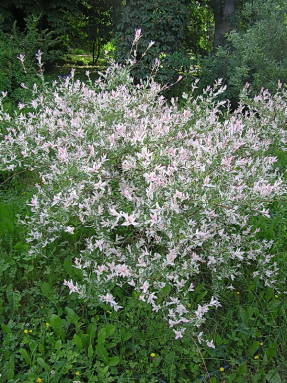 |  |
 | 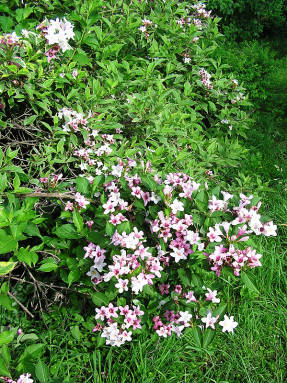 |
In the Botanical Garden, there is a small (0.78 hectare) rose garden with an active fountain, tiled paths, benches and arches for climbing roses. The garden director T.A. Yakovleva, who has worked here for almost 40 years and is the true mistress of an unfading corner of outlandish nature. She closely monitors not only roses, but also all plants, especially in the arboretum and greenhouses.
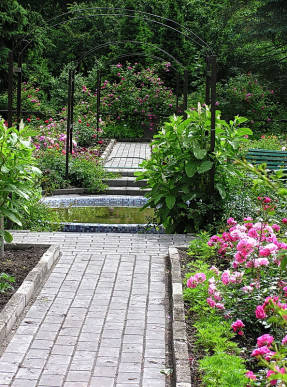 |  |
In the garden there is a large flower garden of the floriculture department, creating the "Big circle of continuous flowering", organized in the 1960s, the area of which has almost doubled to date and is 1.2 hectares. The plantings are dominated by undersized and ground cover perennials with decorative leaves, placed in an "amphitheater" in three tiers; the background is given to tall perennials. The long entrance to the flower garden is framed by hosts (Hostaventricosa, H. xfortunei ‘AlbopictaAurea’).In the foreground is a lush curtain of feathery carnations (Dianthusplumarius) and long-barreled fuopsis (Phuopsisstylosa), especially aromatic after rain. This flower garden, since 2004, has been constantly reconstructed and brought to perfection. A massive planting of hellebore has already been carried out (Helleborus), but the formation of collections of tree peonies (Paeonialutea and P. suffruticosa, 5 varieties)and rhododendrons, especially those suffering from theft, are still going on. Tall Volzhank (Aruncusdioicus), astilbe (Astylbex arendsii); very spectacular bright blue-purple inflorescences of gorgeous geranium (Geraniumxmagnificum ‘Rosemoor’).
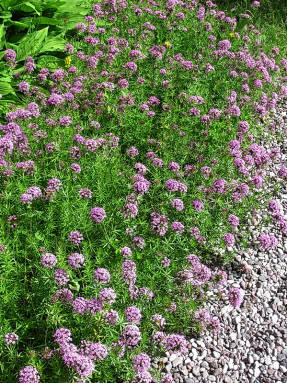 | 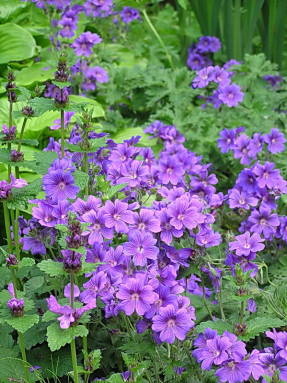 |
In the Botanical Garden, there are 314 native (autochthonous) species among herbaceous plants in open ground. According to A.A. Volodina and I.Yu. Gubareva, 39 introduced species are able to “escape from culture”: Arumalpinum, Chionodoxagigantea, Ch. luciliae, Crocusspeciosus, C. tommasinianus, C. vernus, Fragariamoschata, Galanthusnivalis, Luzulaluzuloides, Muscariracemosum, Ornithogalumnutans, O. umbellatum, Panicumcapillare, Scillasibirica, Tulipasylvestrisand others. They enter the grass stand together with weeds, but so far their distribution is limited only by the territory of the garden. Along with “wild plants” and cultivated plants, the floriculture department has about 1.2 thousand taxa, including 130 medicinal and spice-flavored species and forms. Most of them can be seen in the central part of the Garden in the "Aptekarsky Ogorod", created in 2007 on the initiative of the director T.A. Yakovleva.
Heat-loving plants, originating from the tropics and subtropics, are housed in a greenhouse complex, consisting of 6 sections with an area of about 800 m2. In the smallest breeding greenhouse (96.4 m2), employees carry out cuttings and sowing of seeds. The collections are housed in 5 stock greenhouses: tropical (checkpoint), bridging No. 2 for succulents, the tallest palm (9-14 m high) and the largest (159 m2) subtropical. Since these greenhouses are in dire need of fundamental reconstruction, as before, they are heated by coal, poorly ventilated, and little adapted for irrigation, the most cherished dream of the Garden staff is the construction of a new modern greenhouse with convenient laboratories.
 |
The collection of greenhouse crops includes about 500 items: ferns, gymnosperms and flowering plants (242 genera from 96 families). Almost half of the greenhouse species are cacti. When familiarizing with succulents, I was struck by a cactus without thorns - speckled astrophytum (Astrophytummyriostigma), which for the original shape of the stem is called the "bishop's miter". More than 100 taxa (from cactus and euphorbia) are rare in nature and are listed by the World Wildlife Fund (CITES).
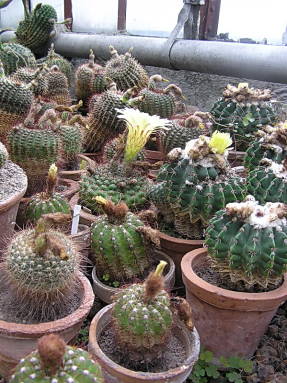 | 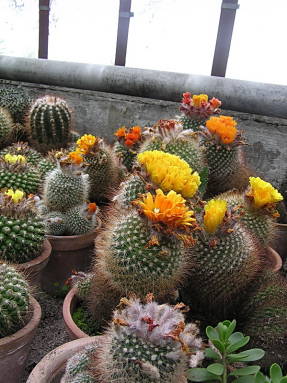 |
The tallest plant in the palm greenhouse is Livistona chinensis (Livistonachinensis) 14 m high, according to some sources its age is 114 years, and according to others - 124 years! Insectivorous plants (6 taxa from 4 genera) are amazing - subtropical sundew (Droseraaliciae), sarracenia purple (Sarraceniapurpurea) and tropical nepentes (Nepenthes) with original trapping leaves in the form of jugs.
 |  |
Up to 50 thousand people come to learn about such natural wonders every year. Although the Botanical Garden is open from April to October-November (depending on the weather), guided tours are available even in winter. More than 200 excursions are held annually. The Botanical Garden in Kaliningrad maintains business contacts with 200 gardens around the world, exchanges seeds, and is a true museum of wildlife, as it contains the richest collection of plants representing the diverse flora of the Earth.
